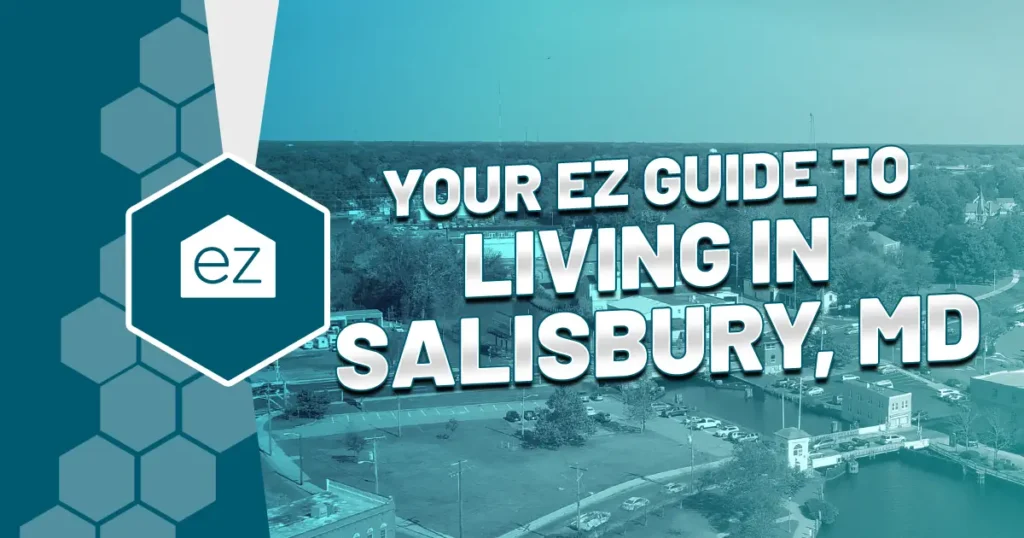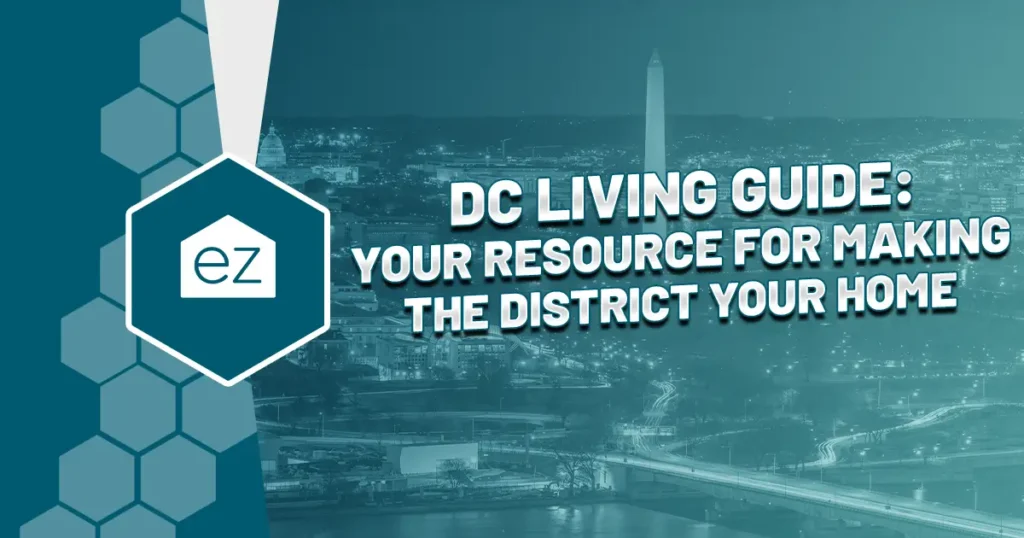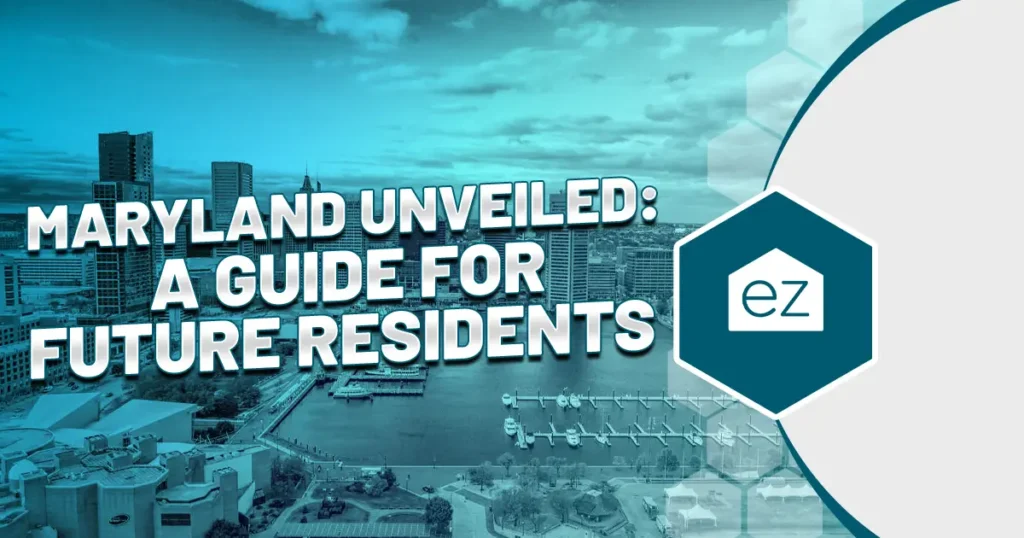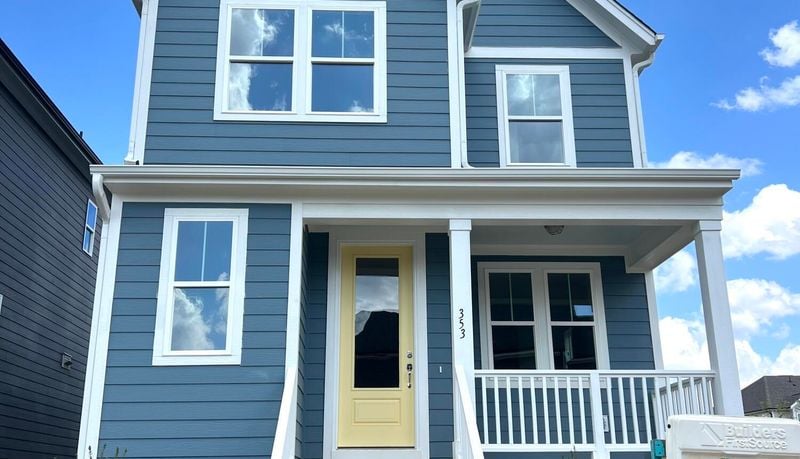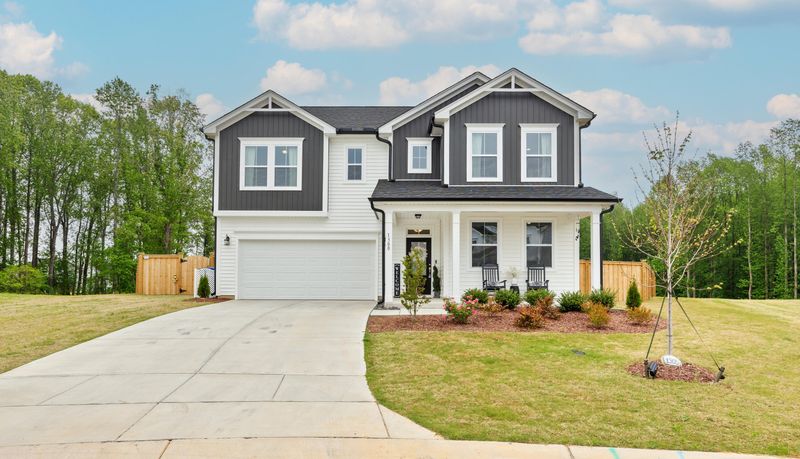Your EZ Guide to Living In Newark, NJ
Brick by brick, Newark built the northeast–almost literally, from the cobblestone streets to the towering skyscrapers. Today, it’s still a vital urban hub, just miles from Manhattan and connected to the greater New York City metro. Historic and industrious, resilient Newark weathered the tides of change and challenges of industrial growth to become a home with a rich cultural tapestry. By choosing to live in Newark for your metro home, you’ll have immediate access to diverse neighborhoods, a thriving arts scene, and ways to commute across the nation. Learn the perks of moving to Newark in our city profile.
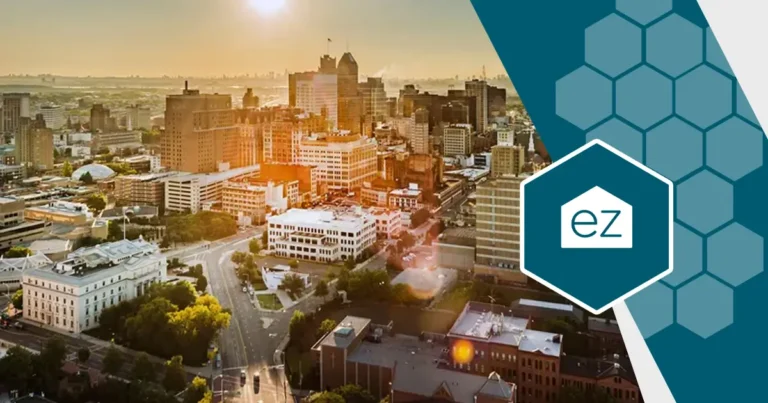
About Newark
Welcome to New Jersey’s largest city–by population, at least. With over 300,000 residents, Newark’s proximity to New York City makes it a Manhattan suburb.
Today, you’ll see multi-story concrete buildings and jammed highways. Back when Puritans founded Newark, it looked completely different. The colonial town along Newark Bay was a sheltered harbor next to bountiful farming lands. As New York emerged as a financial and governmental center, troops battled over its strategic location during the American Revolution. British forces occupied Newark for most of the war.
After the war, the town flourished as an industrial center. Steam picked up in the Industrial Revolution, with Newark’s factories producing ironworks, leather goods, beer, and textiles. All that production required a large and cheap workforce, resulting in waves of immigrants. Hailing from countries in Europe and later freed Africans, Latin, and South Americans, the immigrants brought their culture. The architectural, food, and music traditions shaped Newark’s landscape.
In the latter half of the 20th century, Newark faced economic decline and urban decay. Deindustrialization, suburbanization, and racial tensions contributed to these challenges. Like many densely urban areas, Newark continues to tackle crime, poverty, and economic inequality to improve the quality of life for residents.
Modern Newark is a transportation hub. Its Newark-Liberty Airport is one of the busiest airports in the United States. Amtrak and New Jersey Transit treat Newark as a central rail station.
Living in Newark provides easy access to New York City. Those who work or study in the city but prefer more affordable housing will find the blend of convenient commuting and lower price tags.
Newark Climate
If you’re new to the northeast, chances are you are expecting a four-season climate. How hot and humid summers can get may surprise you about living in Newark. Being so close to the seaboard and waterfront increases the moisture, which amplifies the sunshine and pushes temperatures into the low 90Fs.
But comfortable spring and fall months balance those sweltering temps. Expect daily temperatures to range from 40F to 70F. The beautiful fall colors and spring flowers are even better, encouraging locals to bask in the beautiful days.
We didn’t forget about winters. They are cold. Average highs hover in the mid-30s to low 40Fs, with deep cold snaps. Annual snowfall averages 25 inches, but this varies widely each year. Some weather patterns dump the snow, while others push away significant snowfall totals. In 2023, it only saw 2.3 inches of snow.
Cost of Living
Being this close to New York City and in the U.S.’s largest metro area, the demand to live here pushes the cost of living. Overall expenses run about 35% more than the national average and 12% above the New Jersey average.
Housing contributes to the higher cost of living, and transportation does, too. Newark is very well connected to the greater metro, but the fees associated with public transport or driving a car run much higher here.
However, nearly every expense category runs above national averages.
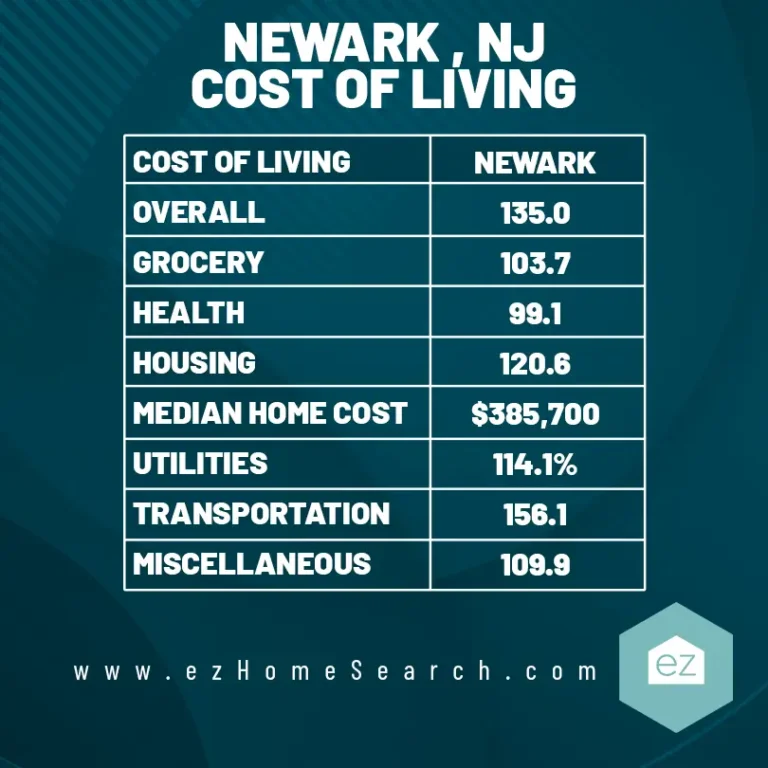
Plus, New Jersey has a higher tax burden across all taxing categories. Comparing the nation’s property taxes, homeowners paid the most in New Jersey.
Real Estate in Newark
Factors such as urban revitalization efforts, proximity to New York City, and increasing demand for housing in the region drive the Newark real estate market. Appreciating property values makes housing affordability a concern for many long-time residents.
As of February 2024, Newark’s median sold price was $415,000, near the national median list price at that time. See more current information on homes in Newark.
A large share of the listings fell into the multi-family home category, which can include duplexes, triplexes, multi-unit buildings, and converted homes.
As you get to know Newark, chances are high you’ll hear about these neighborhoods:
Downtown Newark: New residential buildings, office spaces, and amenities are revitalizing the downtown area’s energy. Its perks include access to transportation hubs, cultural attractions, and employment opportunities.
Ironbound District: Also known as “Down Neck,” this diverse neighborhood may be Newark’s most well-known because of its cultural heritage and culinary scene. Today, Brazilian and Portuguese traditions dominate, but multiple flavors are dished out on the plates of over 170 local restaurants. For residential properties, find historic homes, apartments, and condominiums. The district’s proximity to transportation and amenities adds to its appeal.
University Heights: Proximity to Newark’s Rutgers University campus and the New Jersey Institute of Technology (NJIT) make this a popular neighborhood for students, faculty, and staff. Student housing, apartments, and townhouses are present.
Forest Hill: Known as an affluent residential neighborhood, Forest Hill features historic mansions built on a grand scale and more spacious homes. It attracts homebuyers seeking a suburban feel within the city, with easy access to parks, schools, and cultural amenities.
Weequahic: This residential neighborhood in the South Ward shines for its historic homes, parks, and strong community ties. The neighborhood’s namesake park, Weequahic Park, is a central recreational hub with an 80-acre lake and 311 acres of green space.
South Ward: The South Ward area includes Dayton, Clinton Hill, and Fairmount neighborhoods. While some pockets face economic challenges, investments in housing and infrastructure are boosting the quality of life in some South Ward neighborhoods.
Newark Economy
The job market benefits from being in a major metropolitan area. Commuting into the city for work is common, but you don’t have to. Newark has a robust logistics sector. Among Essex County’s top private employers are United Airlines, NJ Transit, and the Port Authority of New York and New Jersey.
Financial work is another top-employing industry. In addition to Wall Street and associated financial firms in Manhattan, on this side of the Passaic are ADP and Prudential. Health care and life sciences round out the leading job markets.
Getting Around Newark
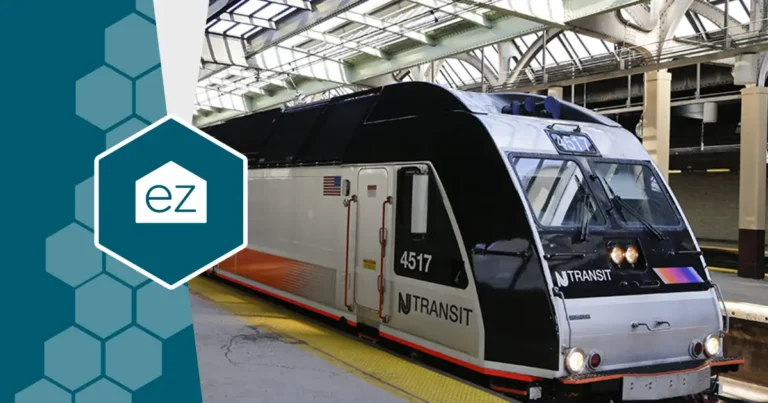
One clear advantage to living in Newark is how incredibly well-connected you are to various destinations through multiple transportation options.
Public transportation is everywhere here, and it’s a combination of buses, light rail, and trains. You’ll have:
- New Jersey Transit (N.J. Transit) connects residents in town and to New York City and key New Jersey cities through buses, Newark Light Rail, and trains.
- The Port Authority Trans-Hudson (PATH) train links Newark to Manhattan, including stops at the World Trade Center, 33rd Street, and other key locations.
- Amtrak’s intercity rail service runs to destinations along the Northeast Corridor, including New York, Philadelphia, Washington, D.C., and Boston.
Need to travel across the country? Newark Liberty International Airport (EWR) is one of the major airports serving the New York City metropolitan area. And it’s in Newark’s yard!
Of course, you can drive. Interstate 95 (I-95), Interstate 78 (I-78), and the New Jersey Turnpike (I-95) all wind through Newark, but drivers beware. Traffic congestion can be and frequently is bumper-to-bumper, especially during rush hour.
Can you walk or bike? That depends. The downtown area and some neighborhoods have a more pedestrian-friendly infrastructure, but it’s not always widespread. That includes rentable motorized scooters.
Education in Newark
Newark Public Schools is New Jersey’s largest school district. A diverse population of over 35,000 students attends one of more than 60 schools, including traditional public schools, magnet schools, and charter schools. For a long time, the school district struggled to meet the state’s demands for quality, leading the State of New Jersey to take it over and directly monitor its activities and operations. As of 2018, the state transitioned control back to Newark Public Schools.
The district meets multiple learning needs through a kaleidoscope of programs. In addition to Pre-K education, specialized schools focus on architecture, fashion, vocational work, arts, and early college.
Newark has a significant presence of charter schools, which are publicly funded but independently operated schools. These schools offer alternative educational approaches and have been part of the city’s broader education reform efforts. Some charter schools in Newark have received national recognition for their academic achievements.
Several higher education institutions are in Newark, including Rutgers University’s Newark campus, New Jersey Institute of Technology (NJIT), and Seton Hall University School of Law. All three are in the nation’s top 150 universities, according to U.S. News and World Report.
Arts and Culture in Newark
Newark has long been a center for culture and the arts. Notable figures in literature, music, and the visual arts have contributed to American culture. Among them are names like Whitney Houston, Paul Simon, Joe Pesci, and Bill Bellamy.
Discover up-and-coming artists and musicians for yourself at First Fridays, a street festival held from April to December. The event is packed with unique street performers, makers, and musicians.
For a more traditional art experience, there’s the Newark Museum, New Jersey’s largest museum. Inside its beautiful building await extensive art and natural history collections from across the globe. A rotation of special exhibitions always keeps a visit fresh (see 2024’s Newark Fashion: Atelier to Runway), but the permanent installations like the Ballantine House highlight the craftsmanship and period-accurate look at opulent 19th-century living. It’ll take more than a day’s visit to appreciate the Newark Museum, as it has 80 galleries.
Performing artists rotate through the world-class New Jersey Performing Arts Center (NJPAC). Its stage features concerts, dance performances, theater productions, and more. Over 10 million people have visited the venue for shows and its deep roster of educational programs and community events.
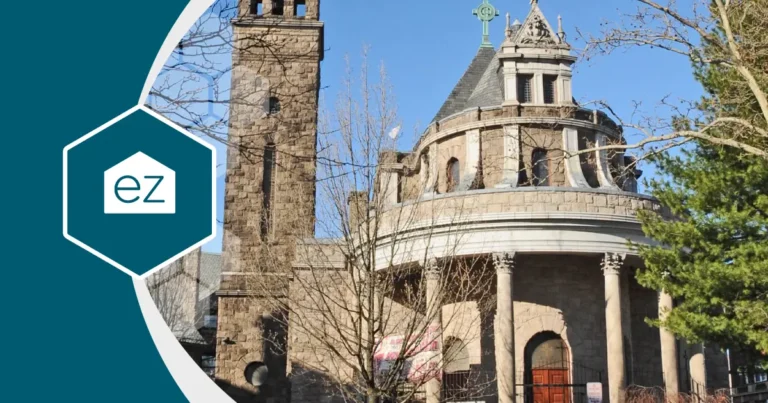
Another beloved landmark in Newark and inspiration for the creative is the stunning architecture of the Cathedral Basilica of the Sacred Heart. Newark has one of the largest Gothic cathedrals in the United States. Take a guided tour to learn about the history and artwork of this historic landmark.
Remember all the immigrants who came to work in Newark’s factories? They left their mark across the city, but visiting the Ironbound District is one easy way to immerse yourself. Sample delicious international dishes at local restaurants, cafes, and bakeries or at cultural festivals, like the Brazilian Day or the annual Portuguese Parade and Festival.
The Great Outdoors
Newark does have greenways and public outdoor spaces for recreation and relaxation. Among its most popular is the Branch Brook Park. Thousands visit in the spring as 5,000 cherry trees burst into white and pink blooms. Having the Cathedral of the Sacred Heart as a backdrop makes it an even more romantic time to visit.
Military Park is another popular central urban green space featuring walking paths, sculptures, and a carousel. Soldiers once marched its field, but today, the park is a gathering place for community events, not military. Come for the food trucks and outdoor activities throughout the year.
Enjoy scenic views of the Passaic River at Newark’s Riverfront Park. Walk or bike the 7.1 miles of trails or stop in on those nice days for a picnic and playground visit for the kids. There’s even an outdoor Fitness Zone with machines to add extra burn.
Another option is to see Newark and the surroundings from the river. Book boat tours or rent kayaks to explore the river. It’s a unique look at the greater metro area.
Living in Newark
Moving to Newark, like any city, has its pros and cons. Living here means you’ll be close to New York City. This dynamic city never sleeps and has even more cultural and entertainment attractions than the ones packed into the New Jersey side. Newark may be the right place to live if the challenges of urban living don’t bother you.
